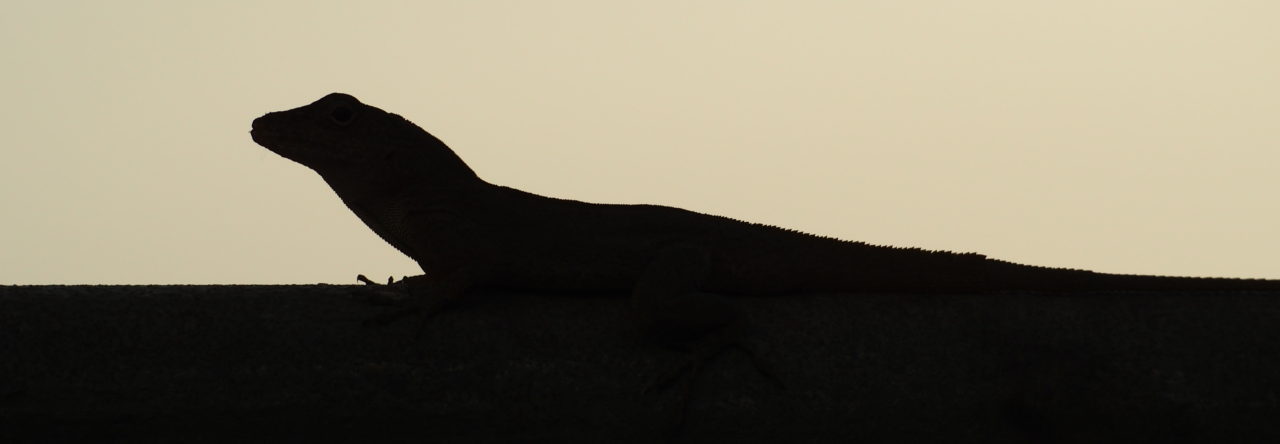Tom Lodge of Thomas E. Lodge Ecological Advisors photographed this blue-bellied beauty at Fairchild Tropical Garden, Miami-Dade County, FL, at 10:00am this past Sunday. The lizard is approximately 40-45 mm snout-vent length. Anyone want to take a crack at figuring out what it is? Clearly not A. sagrei. Could it be A. cristatellus, which occurs there? If not, what?
Latest posts by Jonathan Losos (see all)
- Evolution in Real Time on Lizard Island - March 23, 2025
- Spider Snags Adult Anolis osa - March 22, 2025
- An Homage to the Green Anoles of New Orleans - March 21, 2025




Bill Bateman
In my limited experience I would go for cristatellus – the slightly short-looking head and slightly bug-eyed looked are my clues.
Martha Munoz
Call me crazy – but is that a distichus?
Janson
There are also plenty of A. distichus at Fairchild. That’s my first reaction. Bark anole thuggery!
Philip M. Fortman
It may be a very early juvenile of agama which are everywhere on the grounds of Fairchild Tropical Gardens in south Dade County, Florida. Compare this web photo of “A juvenile red-headed agama, Agama agama africana, photographed at Fairchild Tropical Botanic Garden, 02 September 2011.” http://dusttracksblog.files.wordpress.com/2011/09/2011-09-02-at-14-18-59-2011-09-02-at-14-18-59.jpg?w=400&h=267
I have photographed agama male and female adult there many times. the females exhibit blue patterns and the male have the characteristic orange heads.
Rich Glor
I remark below that I have no idea how to call this one, but there is one thing I am certain of: this is an anole and not an agamid.
Rich Glor
This doesn’t look like distichus or cristatellus to me. The head isn’t right for an adult or sub-adult male cristatellus (I say male because of the unextended dewlap). As for distichus, the limbs seem like they might be too long and the color isn’t right. It’s possible that the weird perspective is throwing me off, but I have no idea how to call this one.
Neil Losin
I’d call this one A. cristatellus. The bluish color on the belly certainly isn’t typical, but the ventral color is pretty variable among individuals I’ve caught in Miami. The pigmentation pattern, particularly in the second photo, says “cristatellus” to me.
Yoel Stuart
I was going to say distichus but Rich has more distichus experience than me. The bluish hue on the ventrum suggests something like grahami or conspersus although the rest of the animal clashes with that guess. Not sure.
geneva
I thought distichus first too, but the bugged out eyes don’t fit and in the second pic I think I see a body length dorsal crest (not diagnostic, but usually distichus have to be pretty worked up to look like that). Also, the dewlap looks red/orange. Has anyone seen anything but a yellow/cream dewlap on distichus in Florida?
Janson
Yeah, looking closer (and lightening the photo on my end), this is more cristatellus than distichus. Fairchild (and especially Matheson Hammock Park next door) has a ton of cristatellus, in addition to distichus, green iguanas, brown basilisks, and agamas. Heck, there are even a handful of A. carolinensis still trying to hang on. Heh. I’ve seen a lot of variation there with cristatellus, but not as much with distichus (they’re usually the ashen-grey tone at Fairchild and Matheson Hammock — in my experience). The Florida Keys do, however, have some wonderfully almost-bluish and ornate distichus. Really cool.
I wrote a five-part Janson-tries-to-learn-about-Cristatellus series last year — photos from Matheson Hammock and Fairchild. A bit of diversity in the Cristatellus! It starts here: http://dusttracks.com/2011/09/08/anolis-cristatellus-part-01/
Joe Burgess
This is a young female A.cristatellus.
Rich Glor
I agree that this is the most likely diagnosis.
Martha Munoz
Is the blue wash on the chest common? In the top picture it almost seems to stretch into a light blue lateral stripe.
Joe Burgess
I think the blue is more of an effect of the lighting and the digital image. Notice the surroundings, they have a blue-ish hue as well.
Rich Glor
I agree here as well, the color balance of the entire photo is a bit off, perhaps due overcast conditions? I initially thought the blue was due to the fact that the animal might be shedding, but it doesn’t look like this is the case.
James Lazell
Well Jonathan: You gonna fess up and tell us what it really is? Skip
Jonathan Losos
I’m voting for cristatellus too, although you never know what can show up in Miami.
Tom McLellan
After seeing this, Rob MacInnes, Scott Hearsey & myself all believe it to be,
Anolis cristatellus.
Respectfully,
Tom McLellan
Walter Meshaka, Jr.
Thanks Jonathan for posting the picture for my friend, Tom, and and thanks everyone for solving the mystery. Makes me wonder what tools these anoles, adults and juvies, have in their toolbox to persist in the face of yet another predator, Agama agama? The Fairchild herpetofauna- it’s a tough crowd.